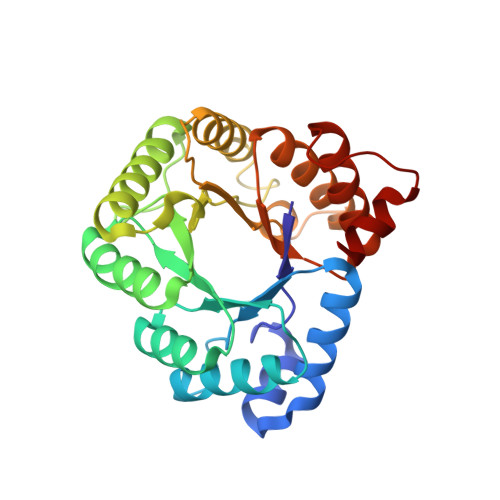Structural and kinetic evidence for an extended hydrogen-bonding network in catalysis of methyl group transfer. Role of an active site asparagine residue in activation of methyl transfer by methyltransferases.
Doukov, T.I., Hemmi, H., Drennan, C.L., Ragsdale, S.W.(2007) J Biological Chem 282: 6609-6618
- PubMed: 17172470
- DOI: https://doi.org/10.1074/jbc.M609828200
- Primary Citation of Related Structures:
2E7F, 2OGY - PubMed Abstract:
The methyltetrahydrofolate (CH(3)-H(4)folate) corrinoid-iron-sulfur protein (CFeSP) methyltransferase (MeTr) catalyzes transfer of the methyl group of CH(3)-H(4)folate to cob(I)amide. This key step in anaerobic CO and CO(2) fixation is similar to the first half-reaction in the mechanisms of other cobalamin-dependent methyltransferases. Methyl transfer requires electrophilic activation of the methyl group of CH(3)-H(4)folate, which includes proton transfer to the N5 group of the pterin ring and poises the methyl group for reaction with the Co(I) nucleophile. The structure of the binary CH(3)-H(4)folate/MeTr complex (revealed here) lacks any obvious proton donor near the N5 group. Instead, an Asn residue and water molecules are found within H-bonding distance of N5. Structural and kinetic experiments described here are consistent with the involvement of an extended H-bonding network in proton transfer to N5 of the folate that includes an Asn (Asn-199 in MeTr), a conserved Asp (Asp-160), and a water molecule. This situation is reminiscent of purine nucleoside phosphorylase, which involves protonation of the purine N7 in the transition state and is accomplished by an extended H-bond network that includes water molecules, a Glu residue, and an Asn residue (Kicska, G. A., Tyler, P. C., Evans, G. B., Furneaux, R. H., Shi, W., Fedorov, A., Lewandowicz, A., Cahill, S. M., Almo, S. C., and Schramm, V. L. (2002) Biochemistry 41, 14489-14498). In MeTr, the Asn residue swings from a distant position to within H-bonding distance of the N5 atom upon CH(3)-H(4)folate binding. An N199A variant exhibits only approximately 20-fold weakened affinity for CH(3)-H(4)folate but a much more marked 20,000-40,000-fold effect on catalysis, suggesting that Asn-199 plays an important role in stabilizing a transition state or high energy intermediate for methyl transfer.
- The Department of Chemistry, Massachusetts Institute of Technology, Cambridge, Massachusetts 02139.
Organizational Affiliation:


















